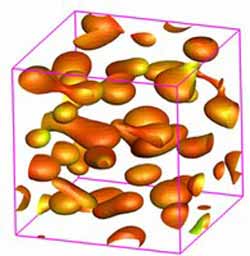Rutgers Researchers Identify Materials That May Deliver More 'Bounce'

Credit: Physical Review Letters<br>Nano-sized particles embedded in alloys can make alloys highly elastic and enable them to convert electrical and magnetic energy into movement.<br>
Rutgers researchers have identified a class of high-strength metal alloys that show potential to make springs, sensors and switches smaller and more responsive.
The alloys could be used in springier blood vessel stents, sensitive microphones, powerful loudspeakers, and components that boost the performance of medical imaging equipment, security systems and clean-burning gasoline and diesel engines.
While these nanostructured metal alloys are not new – they are used in turbine blades and other parts demanding strength under extreme conditions – the Rutgers researchers are pioneers at investigating these new properties.
“We have been doing theoretical studies on these materials, and our computer modeling suggests they will be super-responsive,” said Armen Khachaturyan, professor of Materials Science and Engineering in the Rutgers School of Engineering. He and postdoctoral researcher Weifeng Rao believe these materials can be a hundred times more responsive than today’s materials in the same applications.
Writing in the March 11 issue of the journal Physical Review Letters, the researchers describe how this class of metals with embedded nanoparticles can be highly elastic, or “springy,” and can convert electrical and magnetic energy into movement or vice-versa. Materials that exhibit these properties are known among scientists and engineers as “functional” materials.
One class of functional materials generates an electrical voltage when the material is bent or compressed. Conversely, when the material is exposed to an electric field, it will deform. Known as piezoelectric materials, they are used in ultrasound instruments; audio components such as microphones, speakers and even venerable record players; autofocus motors in some camera lenses; spray nozzles in inkjet printer cartridges; and several types of electronic components.
High Resolution VersionIn another class of functional materials, changes in magnetic fields deform the material and vice-versa. These magnetorestrictive materials have been used in naval sonar systems, pumps, precision optical equipment, medical and industrial ultrasonic devices, and vibration and noise control systems.
The materials that Khachaturyan and Rao are investigating are technically known as “decomposed two-phase nanostructured alloys.” They form by cooling metals that were exposed to high temperatures at which the nanosized particles of one crystal structure, or phase, are embedded into another type of phase. The resulting structure makes it possible to deform the metal under an applied stress while allowing the metal to snap back into place when the stress is removed.
These nanostructured alloys might be more effective than traditional metals in applications such blood vessel stents, which have to be flexible but can’t lose their “springiness.” In the piezoelectric and magnetorestrictive components, the alloy’s potential to snap back into shape after deforming – a property known as non-hysteresis – could improve energy efficiency over traditional materials that require energy input to restore their original shapes.
In addition to potentially showing responses far greater than traditional materials, the new materials may be tunable; that is, they may exhibit smaller or larger shape changes and output force based on varying mechanical, electrical or magnetic input and the material processing.
The researchers hope to test the results of their computer simulations on actual metals in the near future.
The Rutgers team collaborated with Manfred Wittig, professor of Materials Science and Engineering at the University of Maryland. Their research was funded by the National Science Foundation and the U.S. Department of Energy.
Media Contact: Carl Blesch
732-932-7084 x616
E-mail: cblesch@ur.rutgers.edu
Media Contact
More Information:
http://www.rutgers.eduAll latest news from the category: Materials Sciences
Materials management deals with the research, development, manufacturing and processing of raw and industrial materials. Key aspects here are biological and medical issues, which play an increasingly important role in this field.
innovations-report offers in-depth articles related to the development and application of materials and the structure and properties of new materials.
Newest articles

Time to Leave Home? Revealed Insights into Brood Care of Cichlids
Shell-dwelling cichlids take intense care of their offspring, which they raise in abandoned snail shells. A team at the Max Planck Institute for Biological Intelligence used 3D-printed snail shells to…

Smart Fabrics: Innovative Comfortable Wearable Tech
Researchers have demonstrated new wearable technologies that both generate electricity from human movement and improve the comfort of the technology for the people wearing them. The work stems from an…

Going Steady—Study Reveals North Atlantic’s Gulf Stream Remains Robust
A study by the University of Bern and the Woods Hole Oceanographic Institution in the USA concludes that the ocean circulation in the North Atlantic, which includes the Gulf Stream,…



